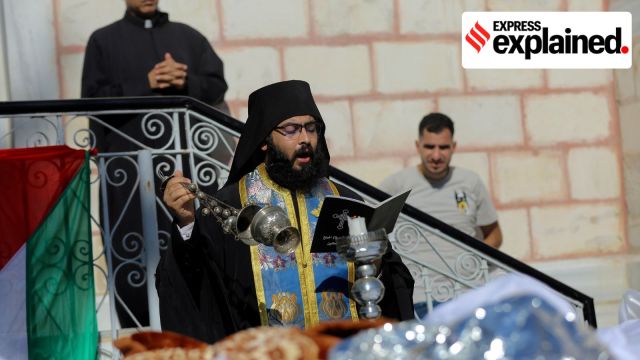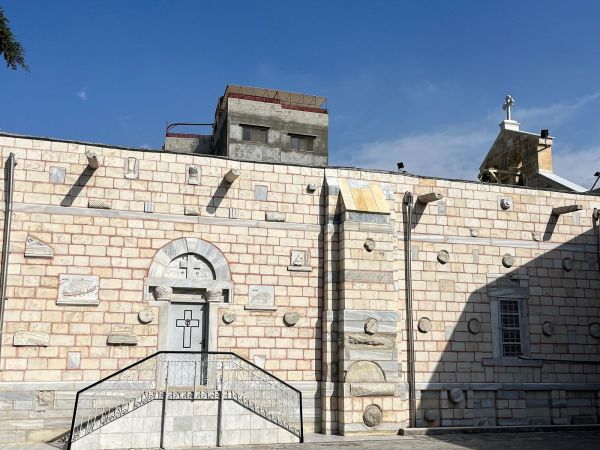Israel missiles hit Gaza’s oldest church: What you need to know about the Church of Saint Porphyrius
The Greek Orthodox Church was consecrated 1600 years ago, and is named after 5th century Saint Porphyrius, known for Christianizing the pagan city of Gaza.
 A priest holds a funeral service for Palestinians who were killed in Israeli airstrikes that hit the Church of Saint Porphyrius in Gaza City. (AP Photo/Abed Khaled)
A priest holds a funeral service for Palestinians who were killed in Israeli airstrikes that hit the Church of Saint Porphyrius in Gaza City. (AP Photo/Abed Khaled) An Israeli airstrike to a building adjacent to Gaza’s historic Church of Saint Porphyrius, belonging to the Greek Orthodox Patriarchate of Jerusalem, has caused extensive damage to the church. According to the Patriarchate, the bombed building was affiliated to the church and collapsed in the explosion after the strike.
Some 500 people had taken refuge at the church compound after the latest round of hostilities broke out. Many were injured, and at least 16 killed in the airstrike late night on Thursday (October 19).
The Greek Orthodox Patriarchate has strongly condemned the air strike, calling it a war crime.
“Targeting churches and its affiliated institutions, in addition to the shelters they provide to protect innocent citizens, especially children and women who lost their homes as a result of the Israeli bombing of residential areas during the past thirteen days, constitutes a war crime that cannot be ignored,” the Patriarchate said on Friday.
The saint who Christianized Gaza
The church, located in the Zaytun Quarter of Gaza’s Old City, was first consecrated around 425 CE. The tomb of its namesake saint, Porphyrius, is located in the church’s northeastern corner.
Born in Thessaloniki, Greece in 347 CE, Saint Porphyrius was the bishop of Gaza from 395 CE to his death in 420 CE. He is known only through Vita Porphyrii, a vivid hagiography written by Mark the Deacon. As per the account, the saint Christianised the “recalcitrant pagan city of Gaza” and demolished all its temples.
 The facade of the church. (Wikimedia Commons)
The facade of the church. (Wikimedia Commons)
Even in the late 4th century, the city of Gaza was known to be hostile to Christians — so much so, that the Christian churches had to be built outside the city walls. After becoming bishop, Porphyrius obtained a degree from the Roman Emperor Arcadius for the destruction of the pagan temples in 402 CE. Eight temples were either pulled down or burnt, with stones from the destroyed temples reused for paving the streets. This way, with the backing of the emperor, Porphyrius Christianised Gaza.
Multiple iterations of the Church
The earliest iteration of the church came up less than five years after Porphyrius’ death, at the place of his burial. But, after the Islamic conquest of the Levant in the first half of the 7th century CE, the church was converted into a mosque.
It stayed a mosque for 500 years till it was reclaimed and rebuilt in the 12th century by some Crusaders. The last major renovations were made in 1856. The Church is architecturally very similar to Great Mosque of Gaza, formerly the Cathedral of Saint John the Baptist.
Today it is one of the three churches in Gaza, the other two being Holy Family Catholic Church on Zeitoun Street and the Gaza Baptist Church.
A refuge for Christians and Muslims of Gaza
Today, there are around a 1000 Christians — most of them Greek orthodox — in Gaza, out of a total population of 2.3 million. It is the most important public institution for these Christian Palestinians.
But it has long been a sanctuary for Muslims, too. Since the beginning of the latest round of hostilities, both Christian and Muslim families had been taking refuge at the church.
During the Israeli Defense Forces’ bombing campaign in the Gaza Strip in July 2014 during the holy month of Ramadan, daily prayers were being held in the ancient church’s courtyard. Even then, the site was hit by Israeli tank shells, with water tanks blown up and a neighbouring house belonging to the church left damaged.
- 01
- 02
- 03
- 04
- 05






































